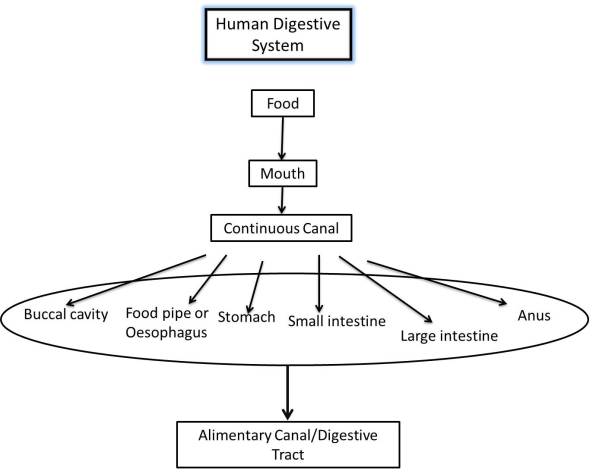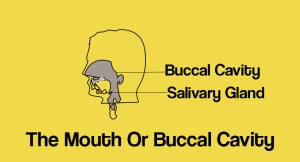Notes of chapter: Nutrition in Animals are presented below. Indepth notes along with worksheets and NCERT Solutions for Class 7.
(1) All organisms including humans require food for growth, repair and functioning of the body.
(2) Animal nutrition includes nutrient requirement, mode of intake of food and its utilisation in the body.
(3) Digestion-
The breakdown of complex substances such as carbohydrates, of food into simpler substances is called digestion.
(4) Various mode of feeding-
| Name of animal | Kind of food | Mode of feeding |
| Snail | vegetables, plants etc. | scraping |
| Ant | insects, sugar | eating |
| Eagle | fish, small animals | tearing |
| Humming- bird | nectar | sucking |
| Lice | blood | sucking &biting |
| Mosquito | blood | sucking |
| Butterfly | nectar | sucking |
| Housefly | human waste, garbage | sponging |
| Human infants | mother’s milk | sucking |
| Snake | small animals | swallow |
(5) Starfish feeds on animals covered by hard shells of calcium carbonate. After opening the shell, it pops out its stomach through its mouth and take the animal inside. Then stomach goes back to inside.
(6) Diagram digestive system-
(i) Flow diagram of human digestive system-
Flow diagram of human digestive system is shown below-

(ii) Diagram of human digestive system –
Diagram of human digestive system is shown below-

(7) The main digestive glands which secrete digestive juices are
(i) The salivary glands
(ii) The liver
(iii) The pancreas
(8) Inner wall of stomach and the small intestine also secrete juices.
(9) The digestive juices convert complex substances of food into simpler ones.
(10) Digestive system is made up of digestive tract and the associated glands.
Work of the different parts of the digestive system-
(i) The mouth and buccal cavity-

(a) The mouth and buccal cavity is used to take food inside the body.
(b) The process of taking food into the body is called ingestion.
(c) Our food is break into small pieces with our teeth in our mouth.
(d) Every tooth is rooted in gums.
(e) Every tooth has different work and appearance. So they have different name.
Different type of teeth-
| S N | Name of Teeth | Number of teeth in mouth | Work of teeth |
| 1 | Incisor | 8 [4 in each jaw] | Cut food |
| 2 | Canine | 4 [2 in each jaw] | Grasping & tearing food |
| 3 | Premolar | 8 [4 in each jaw] | Crushing food |
| 4 | Molar | 12 [6 in each jaw] | Chewing and grinding food |

Number of teeth used in different activities-
| Type of teeth | Number of teeth
Lower Jaw |
Number of teeth
Upper Jaw |
Total |
| Cutting and biting teeth | 4 | 4 | 8 |
| Piercing and tearing teeth | 2 | 2 | 4 |
| Chewing and grinding teeth | 10 | 10 | 20 |
(f) Milk teeth are first set of teeth which grow during infancy and fall off at the age between 6-8 years.
(g) Salivary glands secrete saliva which breaks down the starch into sugars.
Experiment to show salivary glands breaks down the starch into sugars:
Take two test tubes. Put boiled rice in Tube A and put chewed boiled rice in the test Tube B. Add 3-4 ml of water in both the test tubes. Now pour few drops of Iodine solution in both test tubes. After some time Tube A turns blue-black and Tube B shows no colour change. It happens because saliva breaks down the starch into sugars

(h) The tongue is a fleshly muscular organ attached at the back of the buccal cavity.
(i) It can move in all direction from the front.
(j) Work of tongue –

(k)Experiment to check the region of tongue for different tastes-
Take different sample of tastes (i)sugar solution(ii) salt solution(iii)lemon juice(iv)crushed neem. Taste them one by one with separate tooth pick. Results have shown through diagram given below:-

(ii) The food pipe/oesophagus-
(a) The swallowed food passes into the food pipe or oesophagus which is run along the neck and the chest.
(b)The movement of the wall of the food pipe pushed the food downward throughout the alimentary canal.
(c)When food is not accepted by our stomach, it is vomited out.
(iii)The Stomach-
(a) The stomach is a thick walled bag.
(b) It is widest part of alimentary canal.
(c)It receives food from the food pipe at one end and opens into the small intestine at the other.
(d) The inner lining of the stomach secretes mucous. Mucous protects the lining of the stomach.
(e) Hydrochloric acid kills many bacteria that enter along with the food and makes the medium in the stomach acidic and helps the digestive juices to act.
(f) Digestive juices break down the proteins in to simpler substances.
(iv)The small intestine-
(a)The small intestine is highly coiled and is about 7.5 meters long.
(b)It receives secretions from the liver, the pancreas and its wall.
Liver-
- It is a reddish brown gland.
- It is situated in the upper part of the abdomen on the right side.
- It is the largest gland in the body.
- Secretes bile juice that is stored in a sac called the gall bladder. It plays an important role in the digestion of fats.
Pancreas-
- It is a large cream coloured gland located just below the stomach.
- Pancreatic juice acts on carbohydrates, fats and proteins.
- Carbohydrates get broken into simple sugars
- Fats gret broken into fatty acids and glycerol
- Proteins into amino acids.
- Intestinal juice completes the digestion of all components of the partly digested food in small intestine.
(c)Absorption is the process in which digested food passes in to the blood vessels in the wall of the intestine.
(d) Villi are the finger like outgrowths on the walls of the small intestine.
Villus (singular of Villi)-
- Increases the surface area for absorption of the digested food.
- It has a net work of thin and small blood vessels close to its surface. This surface absorbs the digested food materials which are transported to different organs of body via blood vessels.
(e)Assimilation is a process in which nutrients from various external sources integrate to provide energy to their bodies.
(f)In the cells, glucose breaks down with the help of oxygen in to carbon dioxide and water and energy is released.
(g)The undigested and unabsorbed food enter in to large intestine.
(v)Large intestine-
(a) It is wider and shorter than small intestine. It is about 1.5 metre in length.
(b)Its function is to absorb water and some salts from the undigested food material.
(c) The remaining waste passes into the rectum and remains there as semi-solid faceces.
(d) The process in which faecal matter is removed through the anus from time to time is called egestion.
Digestion in grass eating Animals-
(a)Animals which quickly swallow the grass and store it in a part of the stomach, is called ruminant.
(b)Rumen is a part of stomach where animals store swallowed grass.
(c)Cud is partially digested food in rumen by ruminant.
(d)Rumination is a process in which animals chew cud which returns to the mouth.
(e)The grass is rich in cellulose. It is a type of carbohydrate.
(f)Grass cannot be digested by humans and many animals. Because bacteria which digest cellulose are not present in humans.
(g)Caecum is a large sac-like structure between the small and large intestine in ruminants.
Feeding and Digestion in Amoeba-
Amoeba
- Is a microscopic single –celled organism.
- Found in pond water.,
- Have a cell membrane, a rounded, dense nucleus and many small bubble-like vacuoles in its cytoplasm.
- Changes its shapes and position constantly with the help of
- Feeds on some microscopic organisms.
- Pushes out pseudopodia around the food particle and engulf it. The food becomes trapped in a food vacuole.
(a)Digestive juices are secreted into the food vacuole.
(b)Juices act on the food and break it down into simpler substances.
(c) Digested food is absorbed and used for growth, maintenance and multiplication.
(d) The undigested residue of the food is expelled outside by the vacuole.
(e) Pseudopodia are finger like projections which Amoeba pushes out for movement and capture of food. It is also called false feet.

Helping Topics